Macro-nutrient density
Now that we’re building a healthy mind set, it’s important to have at least a basic understanding of what’s good and what’s better left at the store.
Macro-nutrients: Macro-nutrients are nutrients which fuel the body. The main three are carbohydrates, proteins and fats.

2 Types of Carbohydrates:
- Simple- need little if any digestion (meaning easily stored), examples would be “fat free” processed foods, jellies, candy, sweetened cereal, wonder bread.
- Complex- are chains needed to be broken down/digested. The longer it takes to break down the chain, the better (meaning if you’re inactive, it won’t store as quickly). Examples of complex carbohydrates: whole wheat spaghetti, whole wheat bread (3g of fiber or more), brown rice, vegetables, etc.
Key Points ( Carbs are not bad!)
- The body’s preferred energy source. Allowing muscular movement, concentration, focus and so on.
- In conjunction with proteins, they are used in the formation of antibodies and in the formation and maintenance of cartilage and bones.
- When an overload of sugar is in the blood the hormone, insulin is sent to move the sugar to the muscle , liver or if the two are full then to fat.
- Fiber is considered under the carb category, however it yields no calories.
- Each gram of a carbohydrate equals 4kcals. 1g=4kcals
The Takeaway:
Carbohydrates are meant to keep the body running efficiently as well as effectively. The problem occurs when people who live a sedentary lifestyle take in simple carbs throughout the day, and the body basically sends all the energy straight to storage (fat), due to their inactivity. Solution: if you are inactive, carbohydrates are not the bad guy, it’s the choice usually made that is. Switch to your favorite vegetable, fruits, nuts, seeds. When eating, stick to a whole wheat product (not wheat product) for a list of the good and bad email us.
For athletes or people who are active, it is very important to have sugar post workout, however that is a topic we will cover in a future article (The importance of sugar post workout!)

The very popular diet nutrient. In every gym, whether the goal is to gain or lose weight, people take protein in extreme amounts. They believe this will allow the muscles to grow and/or lose fat. Proteins are important but should not be 90% of your eating regimen ( example: High protein diets)
Complete vs. Non-complete proteins:
- Proteins are made up of amino acids. There are 9 Essential amino acids (body cannot produce these). 11 non-essential (your body can produce these on its own). 20 total.
- A complete protein has all 9 essential amino acids, example, yogurt, eggs, fish, meat, poultry etc.
- A non-complete protein is missing one or more of the essential amino acids, examples, beans, pasta, rice, peanuts (including peanut butter)
Key points:
- Allow the rebuilding of muscle
- They allow synthesis and make up of hormones, enzymes, antibodies as well as other key roles in production and development
- To find how much protein you need in a day follow the formula below
Your weight in Kilograms (Divide pounds by 2.2, that will give you your kg weight)
example: 160lbs/2.2= 73kg
When you get your kg weight multiply by .8-1g/kg if you are the avg. person. (athletes can range between 1.2-2g)
73kg x .8= 58g
- For each gram of a protein equals 4kcals. 1g=4kcals
The Takeaway:
Protein plays a huge role in our ability to sustain life; however, this does not mean that you should try to live off of protein. One of protein’s weakest roles is the ability to efficiently produce energy for the body (can’t be good at everything). An extended amount of time of increased protein intake forcing your body to break protein down for energy can cause other serious effects.
Fats:
One of my favorites, as mentioned in a previous article, eating fats doesn’t make you fat! However, eating too much bad fat can make you fat (but that’s with anything).
Types of fats:
Saturated – Over consumption can elevate blood cholesterol levels, especially LDL (the bad cholesterol). Typically saturated fat is found mostly in animal fats and tropical oils. They are solid at room temperature.
Unsaturated– Sticking to the basics, we will keep mono- unsaturated and poly unsaturated together as just unsaturated. Studies have shown unsaturated fats can help increase HDL (good cholesterol). Unsaturated fats typically come from plant sources. As with everything, too much of a good thing can be bad, make sure to still limit your fat intake to about 20-25 % of your diet.
Trans– This one is interesting because it is not a natural fat. We (humans) actually created Trans Fats (“YaY”), the chemical process is called hydrogenation. This is where a mostly unsaturated fat is “hydrogenated” to make it more saturated and thus more solid at room temperature (imagine that in your intestines).
Key points:
- After 30 minutes of activity, carbohydrate stores are exhausted and the body must turn to its reserves of fat for energy.
- Other bodily functions of stored lipids include insulation and formation of a protective cushion for the skeleton and internal tissues and organs.
- Fat is needed for the absorption of several nutrients, including vitamins D, E, A, and K. These vitamins are known as fat soluble vitamins.
- Each gram of fat equals 9kcals. 1g=9kcals
- Though you get more energy in a gram of fat, it takes the body a longer time to use it as energy and that is why carbs are the preferred energy source of the body.
The Takeaway:
Fats are an important part of a nutrition regimen and they allow various functions to happen in the body. From absorption, organ protection, insulation to energy production when glycogen (muscles’ stored energy) stores are running low, fats help keep the body running in an organized fashion.
In summary:
To keep your body strong mentally, physically, and internally, you must ingest all three macronutrients. They all play an important role in the body. Instead of getting rid of one of them due to hype for a month and then going back to your old ways, make a change of which ones you ingest and how often. All your goals will be achieved, but rushing them is not the way to overcome this particular obstacle.
By: Kirill Vaks
Fitness and exercise specialist
BA, CSCS, ACSM-cpt, NFPT-sns
Suggested Articles:
*Starvation mode deciphered
*7 training myths futhter reviewed
Suggested Video:
*Sugar after exercise?
Take action… Now!
Training Aspects Personal Training and Sports Performance:
Training Aspects’ personal trainers and sports performance coaches want you to accomplish your goals. You, as the personal training client, are a reflection of our personal training and group training methods! We are here to help you accomplish all of your personal training goals! Our main training focus are people looking to increase performance, lose weight , lose body fat and increase lean muscle. Whether you live in Cherry Hill, Haddonfield,Marlton, or any of the other surrounding areas we are here to help you Move, Look and feel as you’ve always desired…
Visit us:
Inside of the Flyers Training Center
601 Laurel Oak Rd.
Voorhees, NJ 08043





